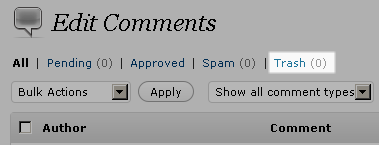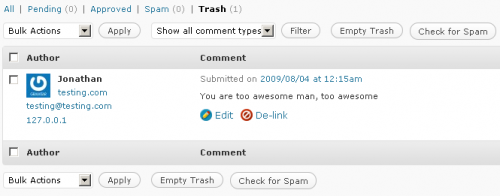One of the new features already implemented in the bleeding version of WordPress aimed at WP 2.9 is the Trash Status. This new status serves two purposes. One functional and the other UI related. First I’ll start with the UI. In the backend of WordPress, the Trash status link will show up in the edit posts page, edit pages, edit comments, and edit attachments. Here is what it’s looking like so far.
In the screenshot above, that link just shows you how many items are in the trash. The next screenshot shows Trash as a quick edit link.
Currently in WordPress, the Trash link is called Delete. When you click on the delete link, a dialog box pops up asking you if you’re sure you want to delete the item. While it’s nice to have a reminder before something ends up deleted, I’ve discovered that I enjoy just hitting the trash link with no reminder box popping up. There is no need for that box since the item is moved to the trash which you can easily recover.
Here is what the actual Trash bin looks like for the comments.
One thing I’ve noticed is that it appears as though each area has it’s own trash bin. That means there are three different trash cans. One for comments, one for pages, and one for posts. I’m not sure if that is the correct way to go about it as I’d like one trash can to rule them all with a drop down box to select different items. Since this is part of the developmental version of WordPress, chances are things will change with it’s implementation before it hits the public. I know at one of the next dev meetings I attend, I’ll be talking about this trash status and adding my input.
Right now, I have no idea on how to configure how the trash bins work in as far as configuring a number of days for items to stay in the trash or for auto emptying. I’m not even sure UI will be added to the backend to configure the behaviour of the feature or if it will need to be configured through the WP-Config file like Post Revisions. I’ve added the topic to the meeting agenda for this week so I’ll update you when I find out what is going on.



Is there any way that the “trash bin” can be made optional, as with Windows?
I hate having to delete things *twice*.